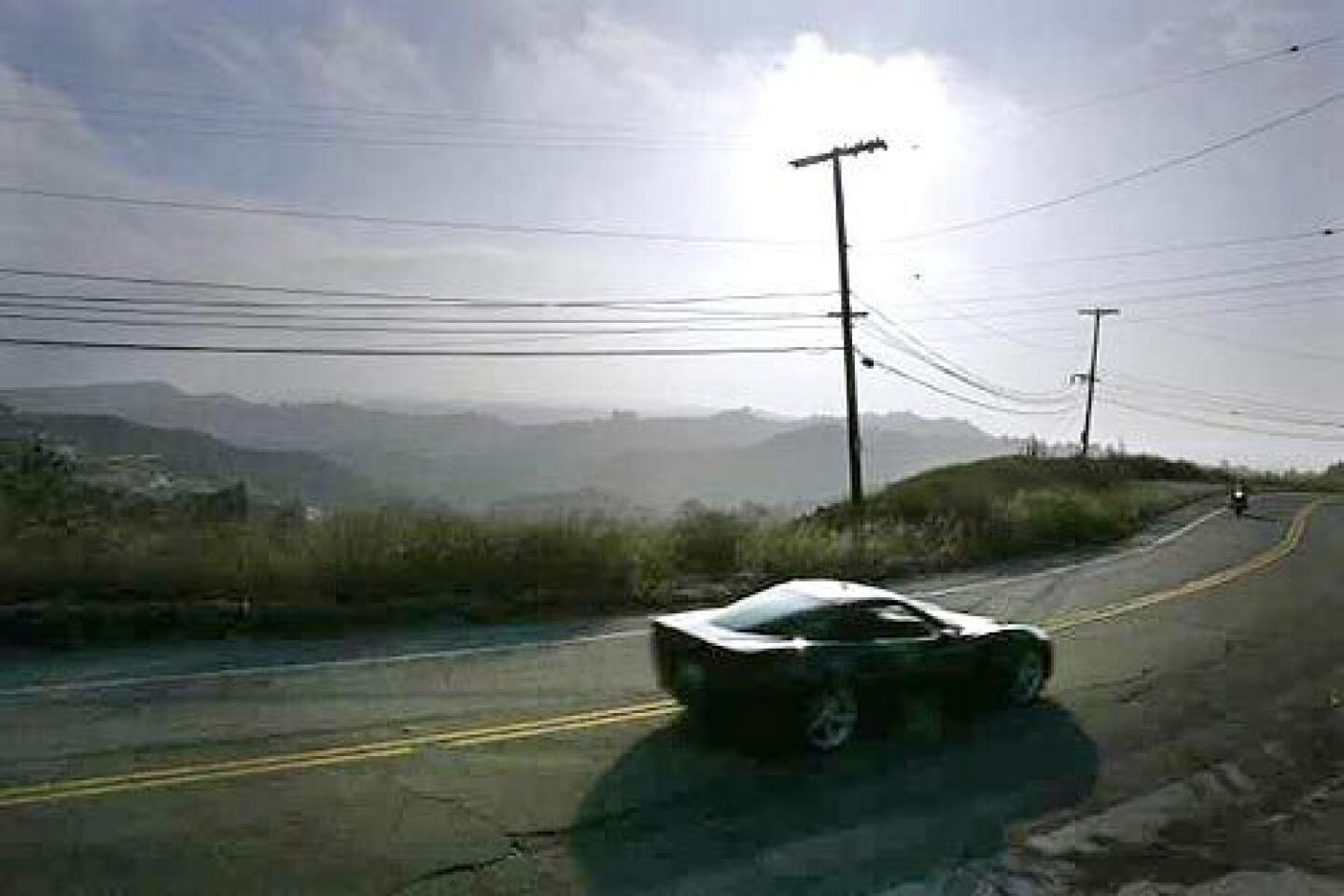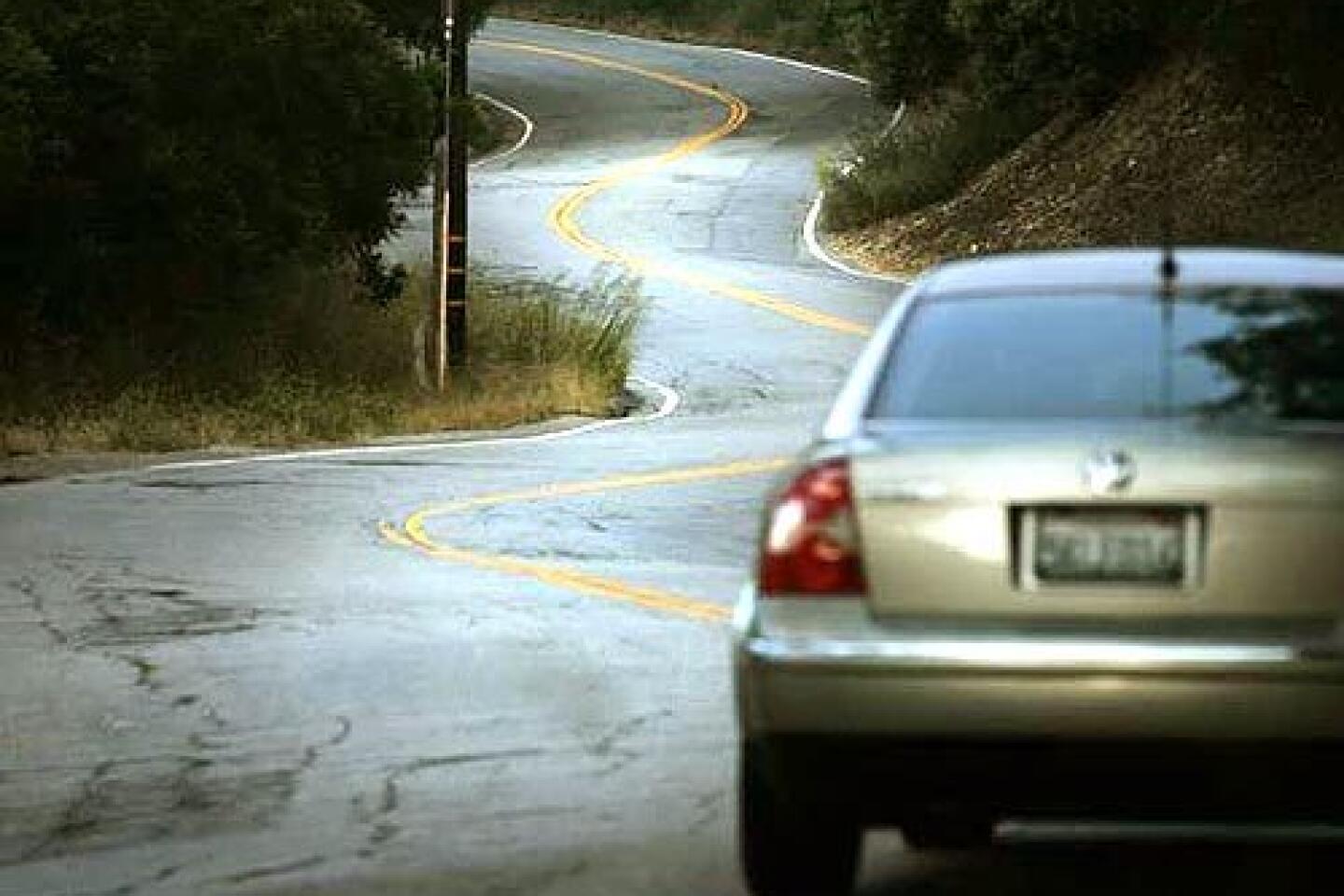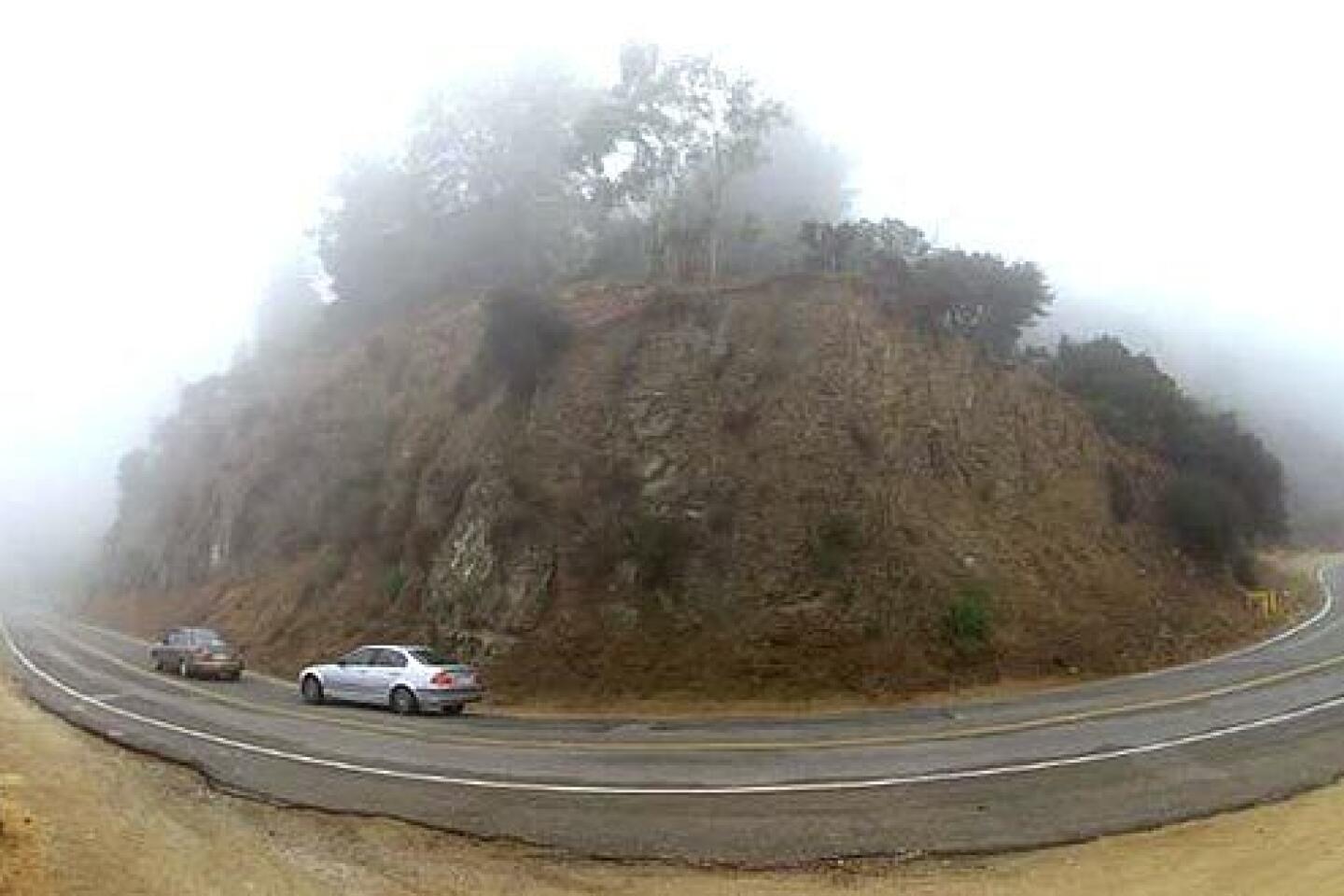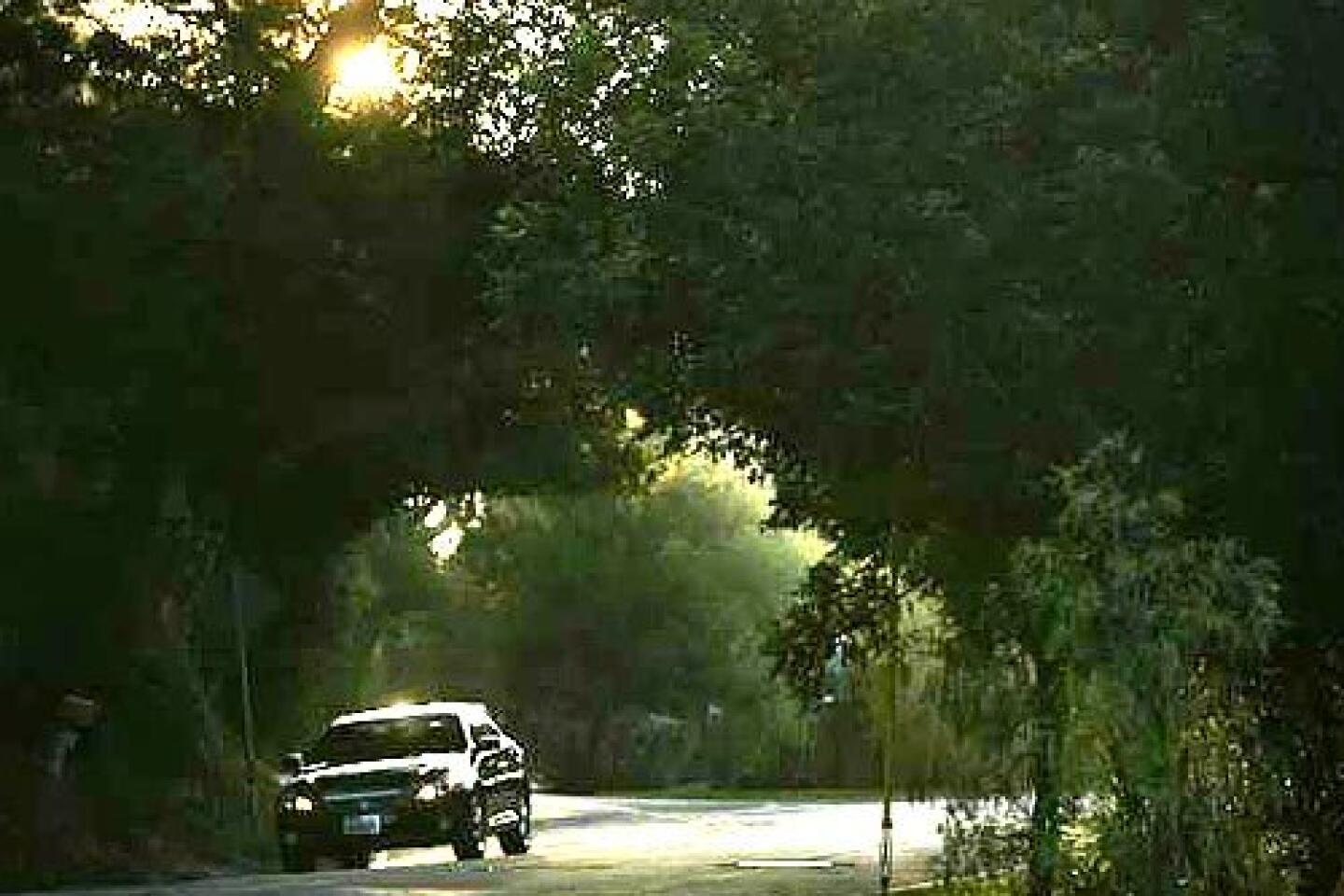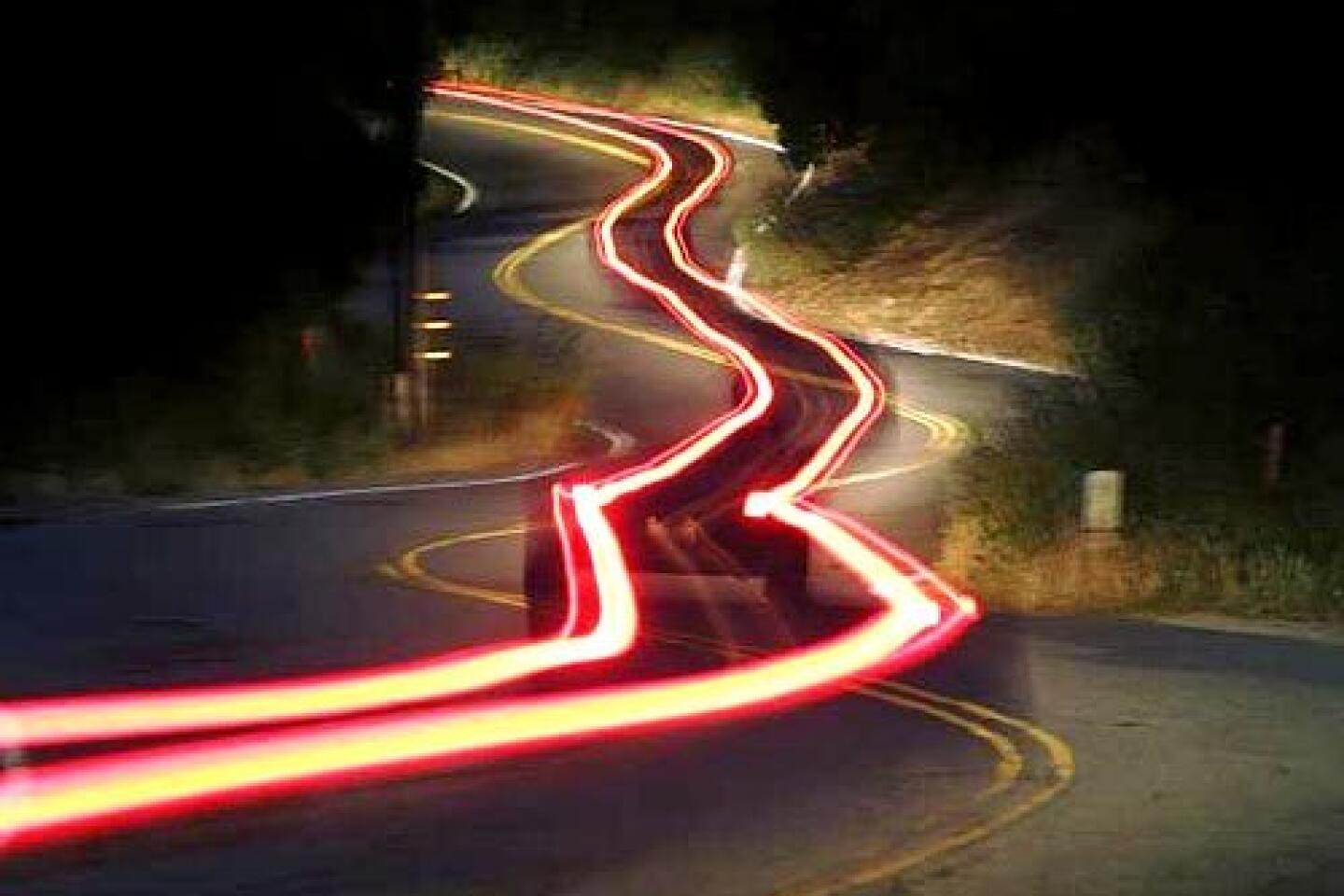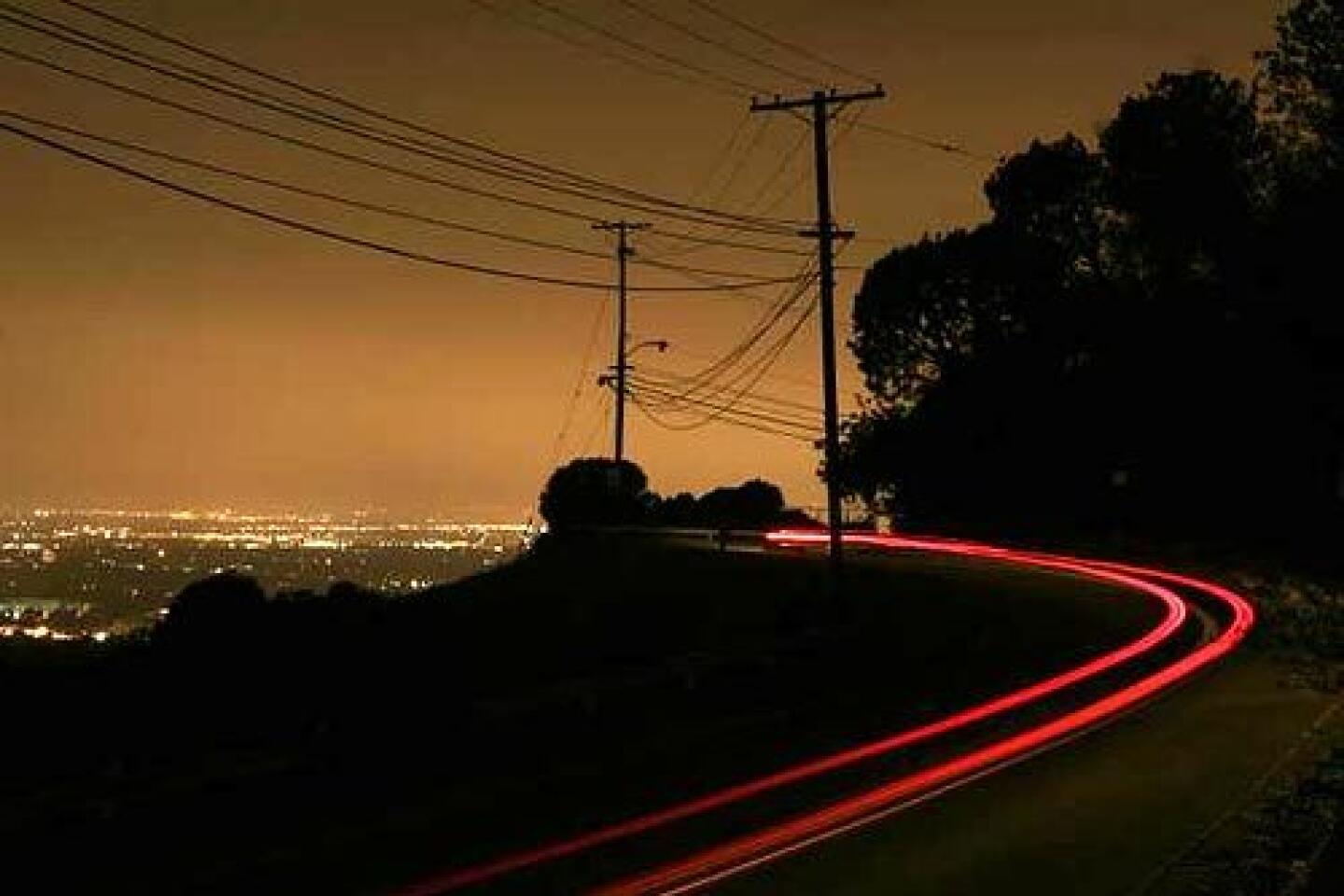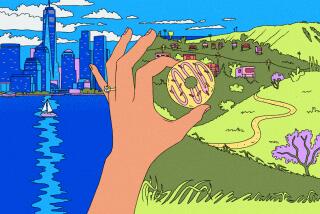‘If you ever want to fly...’
DICK GULDSTRAND punches the accelerator, pulling the Z06 hardtop fast around the first turn on Mulholland Drive. The Cahuenga Pass disappears as the Corvette claws up the grade. With a 427 V-8 under the hood, the car’s a beast, and Guldstrand loves it as much as the road ahead.
He hits 45 where the posted speed is 15. Runyon Canyon slips by. The road hooks right. Guldstrand brakes without downshifting. He knows he doesn’t have to. Mulholland is a reflex for him. He first drove it more than 50 years ago, and in the world of L.A. racers, he’s a legend on this stretch of asphalt. Call him the dean of Mulholland Drive, professor emeritus of this two-lane racetrack.
FOR THE RECORD:
Author’s name: In Wednesday’s Cars Commemorative Edition, a story about Mulholland Drive misspelled the name of the co-author of “The Mulholland Experience” as Dan Mcgee. It’s Dan Magee. —
Fifty-five miles long, Mulholland Drive reaches above the smog, down to the beach and cuts Los Angeles in two. It is not Route 66, though its kicks are plentiful. Nor is it the sand- and salt-spun coastal route. Mulholland is instead a driver’s road, an open invitation to forget about efficiency and expediency and experience a Los Angeles long lost to freeways, traffic and modern life.
Dusty and rugged, ethereal and dark, Mulholland holds truths about Los Angeles that are lost in the flatlands. Gary Cooper, James Dean and Steve McQueen heard the siren call of its S’s and hairpins. David Hockney discovered a new city in its steep canyons, David Lynch found a dreamscape in its night and Michael Stipe said goodbye to the 20th century from its lonely overlooks.
For Gulstrand, it was all about speed. He cut his teeth driving hot rods on Sepulveda Boulevard at 3 a.m. and lake cars on the dusty playas of the Mojave. He got an engineering degree from UCLA, tried his hand in aerospace, but a ’56 Corvette lured him to the track, and in no time he was competing and winning in his class in the big races: the Daytona 24-Hour Race, the Sebring 12-Hour Race, the 24 Hours of Le Mans.
His résumé describes an underworld of racing only Southern California could make possible. He started building his own cars in 1968 (Guldstrand Engineering is still a destination for the truly serious). He’s built cars for Nicolas Cage and Bruce Springsteen, and he’s even dropped a 383 Chevy engine into the governor’s Hummer.
Still, fame is nothing when Mulholland beckons, as it always does, so close and so inviting. Driving this twisty serpent is “almost like freedom,” he says. “It is like you’re cheating death. You push yourself to the point where you’re way beyond doing anything right if something should go wrong.”
A UPS truck pulls in front of him, and he brakes to 25.
WHEN Mulholland Drive was completed in 1924, the city took the day off. It was just after Christmas, and the daylong celebration began in Calabasas.
William Mulholland, the man who stole water from the gods, was the honoree. It being Prohibition, he smashed a bottle of Owens Valley’s finest over a foot-long key that opened a padlock to a floral gate stretched across the road. City fathers in fedoras squeezed in for photos, beaming in no small part over the $200,000 that remained from the $1 million bond issue.
Billed as a “gift of Los Angeles to her 1,250,000 inhabitants,” the highway was named for the city’s chief engineer, but the real hero was DeWitt L. Reaburn. From the groundbreaking in 1923 through the dedication just a year later, Reaburn pushed a crew of nearly 500 men through these mountains with steam shovels and blasting powder.
Today Mulholland winds its way west of Calabasas through arroyos thick with wild flowers and over sandstone ridges. Descending through a steep oak and eucalyptus canyon, it ends at Leo Carrillo State Park, where the surf nearly breaks on its footings.
In the city, it’s Mulholland Drive. In the L.A. County stretch, it’s Mulholland Highway, and through Topanga State Park, it is closed to traffic.
The landmarks of Mulholland are too famous to be anonymous. A few honor legendary drivers; most are merely shorthand for the traits of road.
Guldstrand winds around Deadmans Curve, a sharp hairpin just past Laurel Canyon, and he speeds up in approach to Carls Jr. and Carls, two back-to-back curves carved into the hillside just beneath the radio tower. Sweeper lies ahead, and then Grandstands.
He downshifts as he approaches a red light at Coldwater Canyon. The Corvette rumbles. “Come on,” he mutters. He may be 80, but waiting for the light to change, he’s as restless as a teenager on a drag strip. “Come on.”
A cement mixer comes up the grade from the Valley. “Something you really don’t want to meet on a switchback,” he says as if he knows.
WHEN Hockney painted his pivotal “Mulholland Drive: The Road to the Studio,” speed was his intent as well. Tired of earlier approaches — and a certain static quality to his work — he wanted to create movement. It was late summer, 1980, and he had just moved to Montcalm Avenue, off Woodrow Wilson.
He drove a maroon Fiat — “you couldn’t buy a little American convertible car then; Ralph Nadar had finished them off” — to his studio on Santa Monica Boulevard.
Driving was an experience that he enjoyed — mountain roads at 25 mph, looking at the world in three dimensions — and the more he drove Mulholland and the routes leading to it, the more “the wiggly lines” — as he calls them — entered his life.
He painted “Mulholland” in three weeks, and in the overlapping planes of color, a pointillist blending of light and shadow, almost musical in its bright tonality, he invites the eye to move across this 22-foot-wide canvas as if it were a car on a Sunday drive.
But it is not only the speed of Mulholland that Hockney captures; it is the perspective as well.
“The thrill of Mulholland Drive — like most big thrills about landscape — is a spatial thrill for me,” he says. “And in a sense, Mulholland Drive is not one view. It is many, isn’t it?”
Here are not only the canyonlands of West Los Angeles and Beverly Hills, but also, impossibly, the San Fernando Valley. This bird’s-eye view of the stark and empty grid, drawn from a Thomas Bros. map, makes Mulholland Drive seem almost celestial.
Easy to imagine but hard to explain, the dreams that Mulholland Drive inspire are rooted somewhere between earth and sky. Here on this ridge of mountain, extraordinary for its east-west disposition, you are handed a vantage of superiority that changes your impression of this metropolis.
“I think because of the views, Mulholland gives you a semi-religious feeling of being up there and in control,” says writer David Thomson. “It is where Satan would take you if he were to offer you the city.”
In a breezy 1,200-word essay titled “Beneath Mulholland,” Thomson imagines the road as Marilyn Monroe “lying on her side, half-buried on a ridge of crumbling rock with chaparral, flowers and snakes writhing over her body, and mists, smog or dreams gathering in every curve.”
Mulholland is, he writes, “a pinup and an idea: It has Brancusis in some groomed gardens and beer bottles shattered from target practice .It is a highway made for narcissism and envy, an example of privilege, luxury and airy superiority.”
PRIVATE residences and gated communities, dusty turnouts packed with cars and trucks, red bougainvilleas and tinder-dry chaparral pass in a blur.
Mulholland is, in Guldstrand’s hands, mercurial and feels all the more strange, this two-lane road, for existing in the middle of a city ribboned by six- and eight-lane interstates where drivers join other drivers, car door to car door, in the battle of the daily commute.
Credit the creation of the Mulholland Scenic Parkway Specific Plan in 1992 for preserving its rural isolation, but don’t take it for granted. For almost three decades through the 1970s, the fate of Mulholland was bitterly debated among developers, environmentalists and homeowners. Some would say it still is.
In the 1950s, one plan would have widened the road to accommodate the $10-million, 328-unit Beverly-San Fernando Hotel at the intersection of Mulholland and Coldwater Canyon. In the 1960s, another plan would have increased the graded width by 34 feet and made the Ventura Freeway a little less crowded. Only three votes in the state Senate defeated the bill that would have authorized construction of a $9.3-million, four-lane scenic highway on Mulholland.
Just past upper Coldwater Canyon, Guldstrand hits the European Straight at nearly 60, and where the road gets a little too goofy, as he calls it, with an unexpected bump or two, the rear wheels grind up against the fender well.
“Don’t mind me if I get a little quiet,” he says. “I’m just concentrating. I don’t want anything to happen.”
From the moment it was built and cars started getting fast, Mulholland Drive was a destination for racers, some of whom often tragically underestimated its challenge. Newspaper accounts are often tragic.
The Ferrari was traveling “at a high rate of speed. There were skid marks on the pavement and the car had sailed 150 feet through the air and landed upright.”
“The driver of a car that plunged 300 feet off Mulholland Drive was killed, but his two passengers were thrown out of the vehicle and escaped serious injury.”
“The accident took place on East Road, back of Mulholland Drive when, in making a sharp turn, the soft shoulder of the highway gave way and the automobile overturned and fell to the bottom of the ravine.”
Driving Mulholland — like any great road — is an exercise in physics as the driver courts the breaking point between centripetal and centrifugal force. The road is the constant; the variable is ignorance, and for the best driver, Mulholland is a text set in Braille.
CHRIS BANNING was introduced to readers of The Times in 1982. He was 26 and known as the King of the Mountain.
“My dream was to build the fastest car on Mulholland,” Banning had once said, and with a hand-built, acid-dipped Porsche 911 Carrera — roof chopped and lowered for greater aerodynamics and an engine that could grind out almost 180 mph — he achieved his dream.
Dressed in blue jeans, wearing a pair of aviator glasses, and with a neatly trimmed mustache, he was described as soft-spoken and polite. Today he’s much the same, only a little more nostalgic. Perhaps he has reason. He and writer Dan Mcgee have just published “The Mulholland Experience,” a 302-page history of the road.
Banning grew up on Mulholland, and as a boy he absorbed its legends. Gary Cooper and John Carradine used to mix it up here in their Duesenbergs. James Dean is said to have tested his silver Porsche 550 Spyder on these curves before driving it to a race in Salinas that he never made.
Late at night, Banning listened through the open louvers of his family’s home off Java Drive to the racers in the distance. Of all of them, Charley Woit made the greatest impression — at least until Banning was old enough to make his own.
Mulholland Charley, as Woit was called, was legendary for driving with one hand on the wheel — a ’51 GMC truck, a ’55 Hillman Minx or a 427 Corvette — and the other on a can of beer. He dominated the racing circles up here, and then one day, he disappeared, letting his reputation drift into legend, allowing a younger generation to come into play.
The races were always at night when the sweep of headlights showed oncoming traffic, and spectators, armed with CBs, police scanners and flashlights, could keep the coast clear. The course, laid between Coldwater Canyon and Deadmans, had 11 turns, a decent straight away, a pit area and most importantly, fewer driveways than anywhere else along Mulholland. It was, in short, perfect for following the leader, with speeds often running in excess of 100 mph.
Racing hit a fever pitch during the summer of ’82. A year before, Polygram Pictures came out with “King of the Mountain,” starring a young Harry Hamlin and the veteran Dennis Hopper.
Between 1980 and 1982, the so-called Mulholland International Raceway saw four deaths and 140 injuries. When a hit-and-run driver struck a 12-year-old boy at 1:30 on a Sunday morning, the L.A. City Council adopted an emergency ordinance that permitted them to close segments of Mulholland.
The racing scene never recovered.
“THERE are three parts to every turn: the entry, the apex and the exit,” says Guldstrand. “The whole idea is to try to drive it as straight as possible.”
Which is of course impossible as he enters Sideways, an ever-tightening hairpin, followed by the Identicals, a pair of perfectly matched turns adjacent to the Marlon Brando-Jack Nicholson complex. Warren Beatty and Annette Bening’s home is just ahead.
At Benedict Canyon, a semi-trailer truck pulls in front of him. “If we didn’t have bad luck, we’d have none,” he says.
In David Lynch’s film of the same name, Mulholland Drive is not so much a location as it is a dimly lighted nightscape laid out before a long and complicated dream of guilt and despair.
“What are you doing? You don’t stop here “ asks the dark-haired woman.
It’s the first line of dialogue. After an eerie crawl through the Hollywood Hills lighted only by headlights, the Cadillac she’s riding in stops at a blind curve.
“Get out of the car,” the driver says.
Then there’s a cut.
A convertible and a late model sedan are drag racing. Two teenage girls are standing up through the sunroof of the sedan screaming as their hair is whipped straight back.
“The cars are traveling so fast,” reads the screenplay, “that they seem to almost float as they fly with psychotic speed down both lanes of Mulholland Drive.”
Nighttime transforms Mulholland. Gone are the expansive views, the vast concrete grid set between the mountains and the sea. At night, Mulholland is a place to be reminded how mysterious this city is, one bright street after another disappearing into some vanishing point on the other side of the mountains.
No wonder before the “No Parking, 9 p.m. to 6 a.m.” signs were posted at the overlooks, it was a make-out spot for teenagers, a destination for illicit rendezvous. A cool wind blows in from the Pacific. Crickets chirp above the drone of the city. Dogs bark in the canyon below.
Of course, it wasn’t always like this. One developer spoke to The Times the day after the highway opened and described the view at night as “a gorgeous spectacle of illumination . The great vault above and the sea of sparkling gems below seem to reflect eternal harmony, and here, from your living room on Mulholland Highway, the Great Producer stages for you each night a glorious spectacle that cannot be described.”
When Michael Stipe, lead singer for R.E.M., wanted to write a farewell to the 20th century, he set the song on Mulholland Drive because “nowhere seemed more perfect than the city that came into its own throughout the 20th century always looking forward and driven by greater ideas of a greater future at whatever the cost.”
“Electrolite” is the final track on R.E.M.’s 1996 CD “New Adventures in Hi-Fi,” a song distinguished for its lyricism on an album marked by a more rocking sound. Here are all the pop hooks: a whisk on the drums, a banjo and Stipe’s familiar narrative style.
If you ever want to fly.
Mulholland Drive.
Up in the sky.
Stand on a cliff and look down there.
Don’t be scared.
.You are alive.
Stipe says he associates the sight of the city from on high with “a blanket of stars or those bizarre sea creatures that light up when you stir up the water.”
“Mulholland is the place in films where you get a distance and the awe, of the city built on dreams and fantasy,” says Stipe, adding, “far away enough to not smell it but to marvel at its intensity and sheer audacity.”
ALMOST two miles past the Sepulveda Pass, Mulholland hits Encino Hills Drive, makes a sharp left and turns to dirt. The clearance on the Corvette is low, so Guldstrand turns around, sheathing the car in a cloud of sweet smelling dust. Just as fast, it blows off.
As he passes the racer’s landmarks on the way home, it becomes clear how easily Mulholland can enter the bloodstream of those who take the time to learn its grades, its goofiness and curves.
To get out of your car and to stand in the middle of the road on the double yellow line is to feel the heat of the pavement, the enticement of speed, and at the end of the day, as the sun pours its hazy beams through the canyons and tree-lined ridges to the west, you feel the sway of the road long after you’ve left it.
FOR THE RECORD:
Map error: A map of Mulholland Drive that accompanied the story showed a landmark called the S straight. It is called the S’s. —
More to Read
Sign up for Essential California
The most important California stories and recommendations in your inbox every morning.
You may occasionally receive promotional content from the Los Angeles Times.
